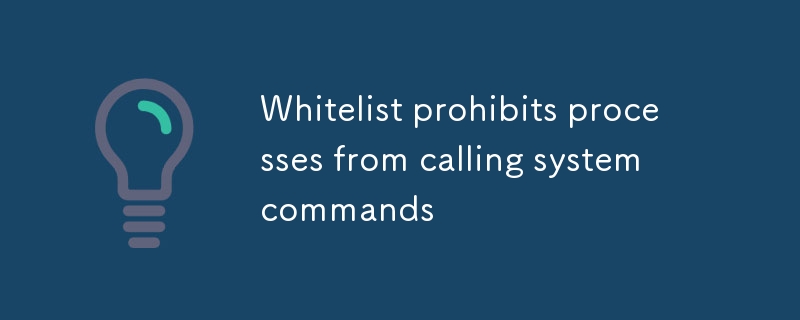ホワイトリストにより、プロセスによるシステム コマンドの呼び出しが禁止されます
- DDDオリジナル
- 2024-08-16 10:15:17570ブラウズ
この記事では、システム コマンドの呼び出しを禁止されたプロセスをホワイトリストに登録する方法について説明します。禁止されたプロセスをホワイトリストに登録すると、機密システム コマンドへの不正アクセスを防止し、セキュリティ侵害やデータ漏洩を軽減できます。この記事の内容は次のとおりです

システム コマンドの呼び出しから禁止されているプロセスをホワイトリストに登録する
システム コマンドの呼び出しから禁止されているプロセスをホワイトリストに登録する方法
システム コマンドの呼び出しから禁止されているプロセスをホワイトリストに登録するには、 を使用できます。 Auditd ツールを使用して、特定のプロセスに特定のコマンドの実行を許可するルールを作成します。その方法は次のとおりです:auditd tool to create a rule that allows specific processes to execute certain commands. Here's how you can do it:
-
Create a rule file: Create a file called
/etc/audit/rules.d/whitelist.ruleswith the following content:
<code>-w /usr/bin/command -p x -c never</code>
In this rule, /usr/bin/command is the command that you want to whitelist, -p x specifies that the rule applies to processes with executable permission, and -c never specifies that the rule should never be enforced. You can add multiple rules to the file, each on a separate line.
-
Load the rules: Load the rules file into the
auditdsystem by running the following command:
<code>sudo auditctl -R /etc/audit/rules.d/whitelist.rules</code>
-
Restart
auditd: To ensure that the rules are applied immediately, restartauditdby running:
<code>sudo systemctl restart auditd</code>
What are the benefits of whitelisting forbidden processes?
Whitelisting forbidden processes can help prevent unauthorized access to sensitive system commands. By restricting the ability of certain processes to execute specific commands, you can reduce the risk of security breaches and data leaks.
What are some examples of forbidden processes?
Forbidden processes are typically processes that are not essential for the operation of the system and that could be used to compromise the system if they were allowed to execute certain commands. Examples of forbidden processes include:
- Processes that have excessive file permissions
- Processes that are running with root privileges
- Processes that are known to be vulnerable to exploits
How can I audit forbidden processes?
You can audit forbidden processes by using the auditctl tool. To do this, run the following command:
<code>sudo auditctl -w /usr/bin/command -p x -c id</code>
This command will create an audit rule that logs all attempts by processes with executable permission to execute the /usr/bin/command
- ルール ファイルを作成します:🎜 次の内容を含む
/etc/audit/rules.d/whitelist.rulesというファイルを作成します。
<code>sudo cat /var/log/audit/audit.log | grep /usr/bin/command</code>🎜 このルールでは、
/usr/bin/command はホワイトリストに登録するコマンドです。-p x はルールが適用されるコマンドを指定します。 -cnever は、ルールを決して強制しないことを指定します。複数のルールをファイルに追加し、それぞれを別の行に追加できます。🎜- 🎜ルールをロードします:🎜 次のコマンドを実行して、ルール ファイルを
auditdシステムにロードします。次のコマンド:
- 🎜
auditdを再起動します:🎜 ルールがすぐに適用されることを確認するには、auditd を再起動します。を実行して:
- 過剰なファイル権限を持つプロセス
- root 権限で実行されているプロセス
- エクスプロイトに対して脆弱であることが知られているプロセス
auditctl ツールを使用して、禁止されたプロセスを監査できます。これを行うには、次のコマンドを実行します。🎜rrreee🎜 このコマンドは、/usr/bin/command コマンドを実行する実行権限を持つプロセスによるすべての試行をログに記録する監査ルールを作成します。次のコマンドを実行すると、監査ログを表示できます:🎜rrreee以上がホワイトリストにより、プロセスによるシステム コマンドの呼び出しが禁止されますの詳細内容です。詳細については、PHP 中国語 Web サイトの他の関連記事を参照してください。

